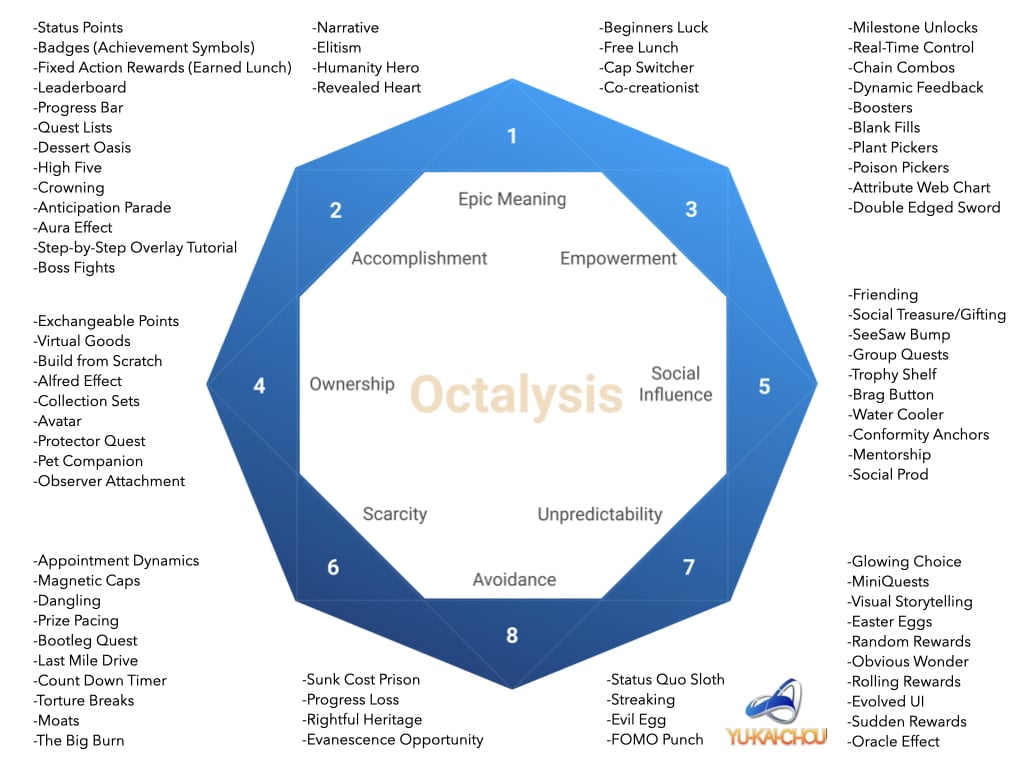Gamification Design Frameworks
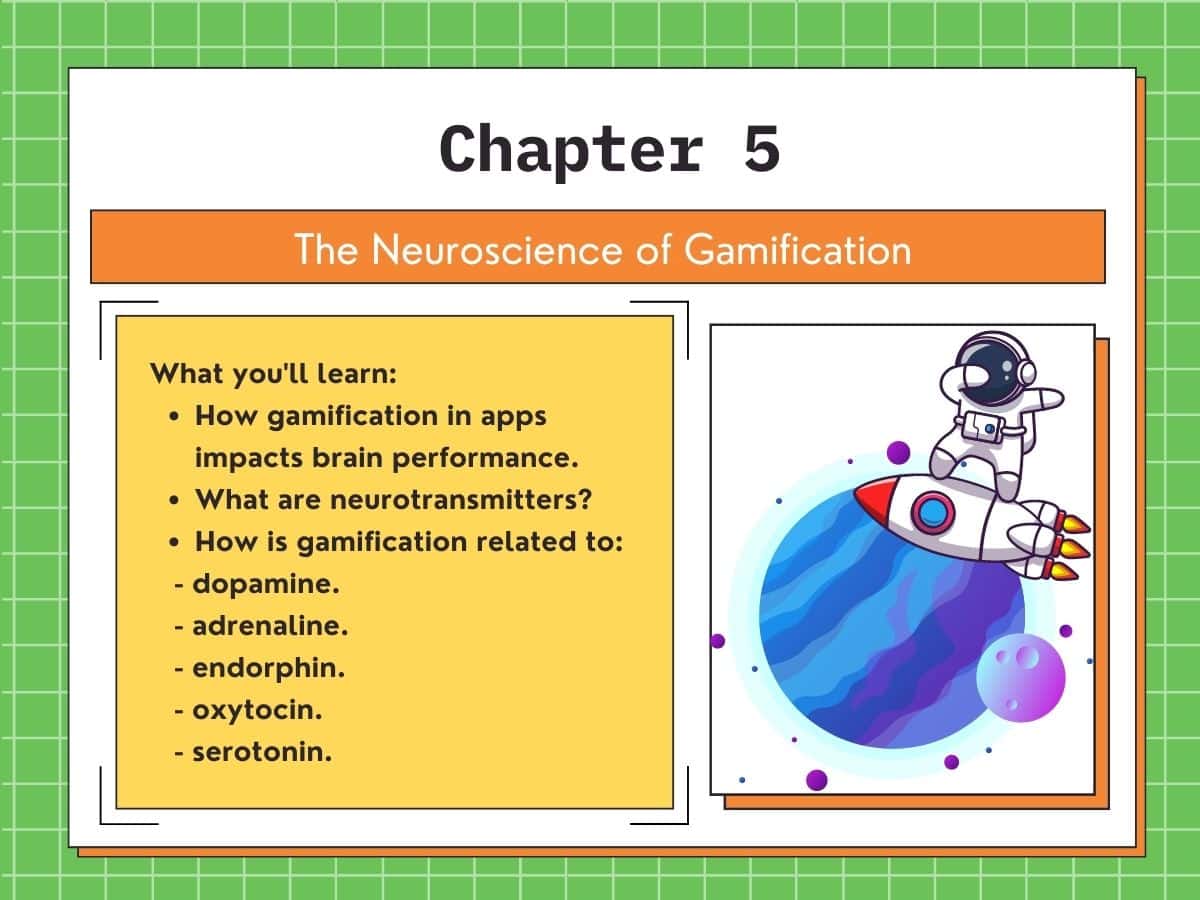
Gamification design frameworks: Here’s one of the most anticipated topics for our Gamification Guide! After all, frameworks are essential resources for every organisation and individual designing engaging and effective gamified products and services.
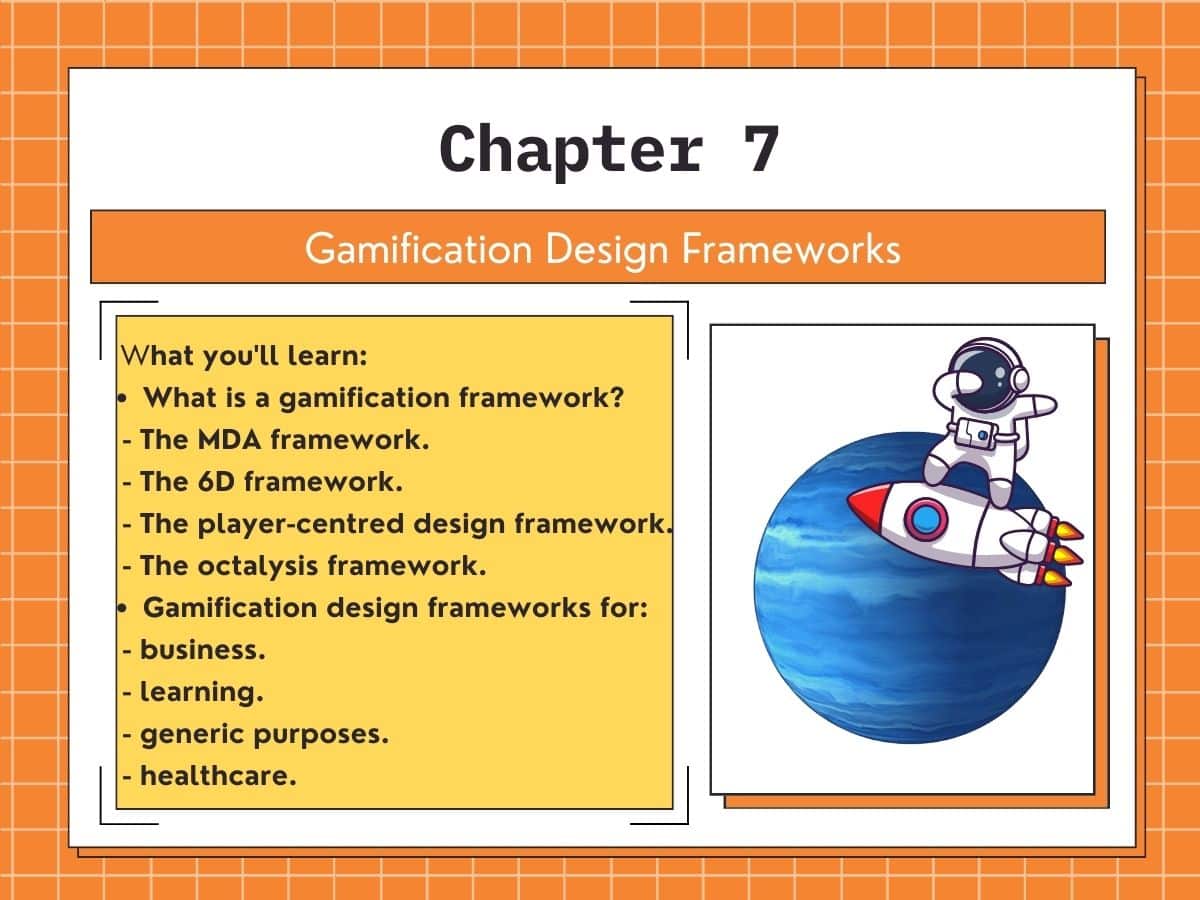
Chapters
You are in Chapter 7 of the Beginner’s Gamification Guide.
Since the creation of the term “gamification” in 2002 by Nick Pelling, this subject has largely been explored in various fields, including education, psychology, game theory, human-computer interaction, business, and medical science.
Despite the widespread attention, approaches to gamification design vary widely depending on the application area.
Today our mission is to introduce you to all 39 unique gamification design frameworks so you can understand gamification design frameworks in all these areas.
Let’s dive into these existing gamification frameworks and look closely at how they operate.
A gamification framework is a set of guidelines or design principles to incorporate game design elements into non-game contexts, such as business, education, or healthcare.
The intention is to make the digital experience more engaging, motivating, or entertaining.
These guidelines provide structure and direction to the process of gamifying a product or service, ensuring that the use of game design elements is adequate, relevant, and appropriate for the intended audience and purpose.
Important note:
While gamification design frameworks can provide structure and direction to the gamification process, their use is not necessarily a requirement.
Some designers may approach gamification design through a more intuitive, creative, or experimental process without relying on a specific framework.
Whether to use a framework depends on the individual designer’s preferences, experience, and the project’s particular needs.
Ultimately, the effectiveness of gamification design depends on the designer’s ability to effectively utilise game design elements to meet the needs and goals of the intended audience and context.
#1. The MDA framework: An approach to engaging video game design (2004)
The MDA framework was developed by Robin Hunicke, Marc LeBlanc, and Robert Zubek to understand the design of engaging video games.
The framework stands for mechanics, dynamics, and aesthetics, which correspond to the three essential components of a game.
Simply put, mechanics refer to the game’s rules and define the playing environment’s boundaries. While dynamics describe how you play the game, aesthetics refer to the feelings a player should have while playing the game.
Let’s check in detail what each element means.
Three game components to design an engaging game
The game’s aesthetic.
What makes a game “fun”?
Understanding how games evoke certain emotions is challenging because the vocabulary used to describe games is limited.
It is essential to use a more specific vocabulary when understanding the aesthetics of a game rather than relying solely on terms like “fun” and “gameplay.” This vocabulary includes sensation, fantasy, narrative, challenge, fellowship, discovery, expression, and submission.
No formula outlines the combination and proportion of factors that result in “fun”.
Think of games like Minecraft, Candy Crush, Grand Theft Auto, and Dark Souls.
They are all “fun” games, but they evoke different emotions in players. Minecraft focus on exploration and creativity, Candy Crush is about solving puzzles, Grand Theft Auto is an open-world action game, and Dark Souls is a challenging role-playing game.
Using the MDA framework, designers and players can establish a shared understanding of the game’s intended aesthetic goals.
For example, a designer could use the MDA framework to create a game emphasising puzzle-solving. While players could use it to understand if a game meets their expectations for a more puzzle-oriented experience.
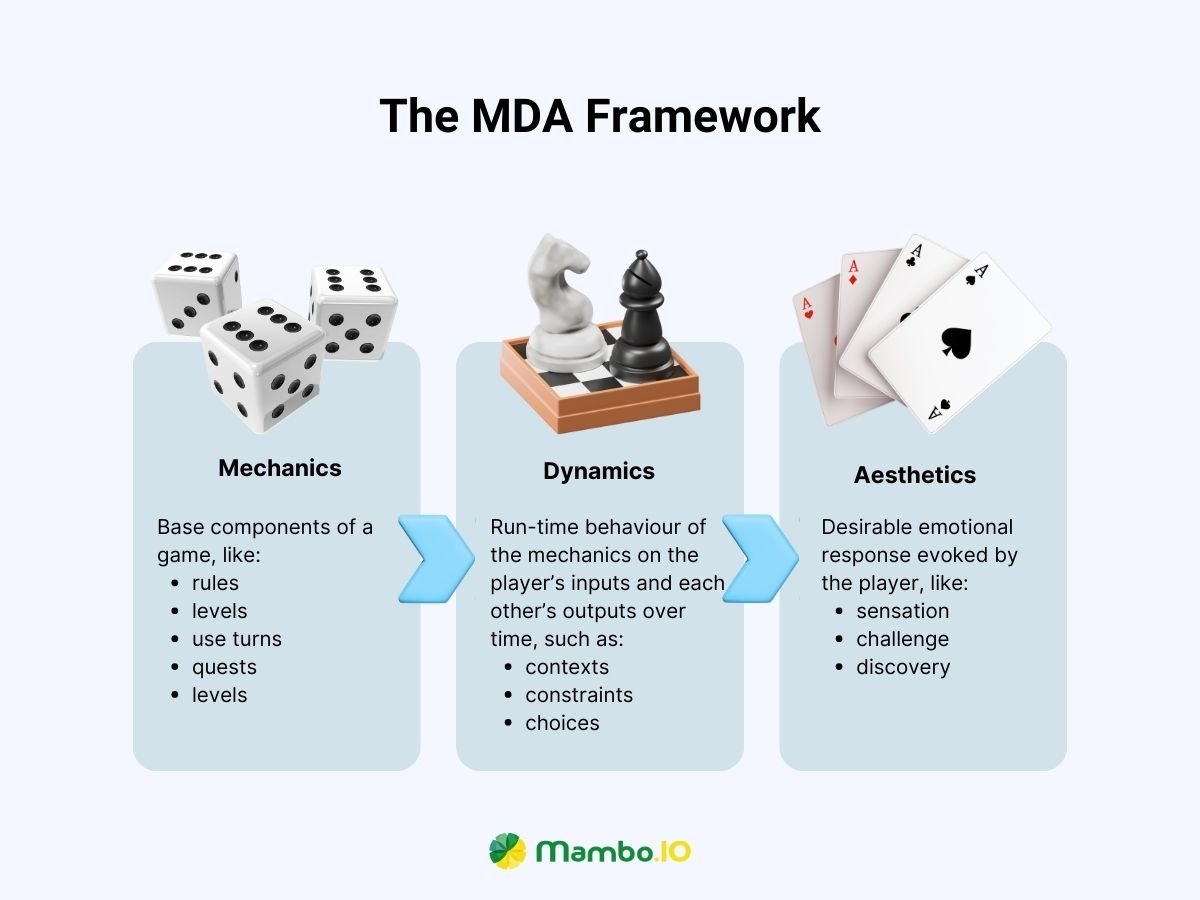
Dynamic models
The dynamics are responsible for creating aesthetic experiences in a game.
For example, when you make a challenge through time pressure and opponent play, or when fellowship is encouraged through shared information or winning conditions that are more difficult to achieve alone. Or when expression is enabled through dynamics that allow players to leave their mark.
Dramatic tension is created through the dynamics. It encourages rising tension, release, and denouement.
By developing models that describe the interactions of mechanics and dynamics, game designers can better understand how to create the desired aesthetic experience in the game.
The MDA framework is helpful for game designers as it helps them know how mechanics, dynamics, and aesthetics are interconnected and can be used to create engaging video games.
Game mechanics
Game designers use the game’s mechanics to create a specific type of playing environment that will evoke particular emotions, such as fun or FOMO (fear of missing out), in the player.
In other words, mechanics refer to the various actions, behaviours, and control mechanisms available to the player within a game.
These mechanics (rules, levels, feedback, for example) support the gameplay dynamics. They are an essential aspect of game design as they determine what the player can and cannot do within the game world and can impact the overall player experience.
#2. The 6D framework (2012)
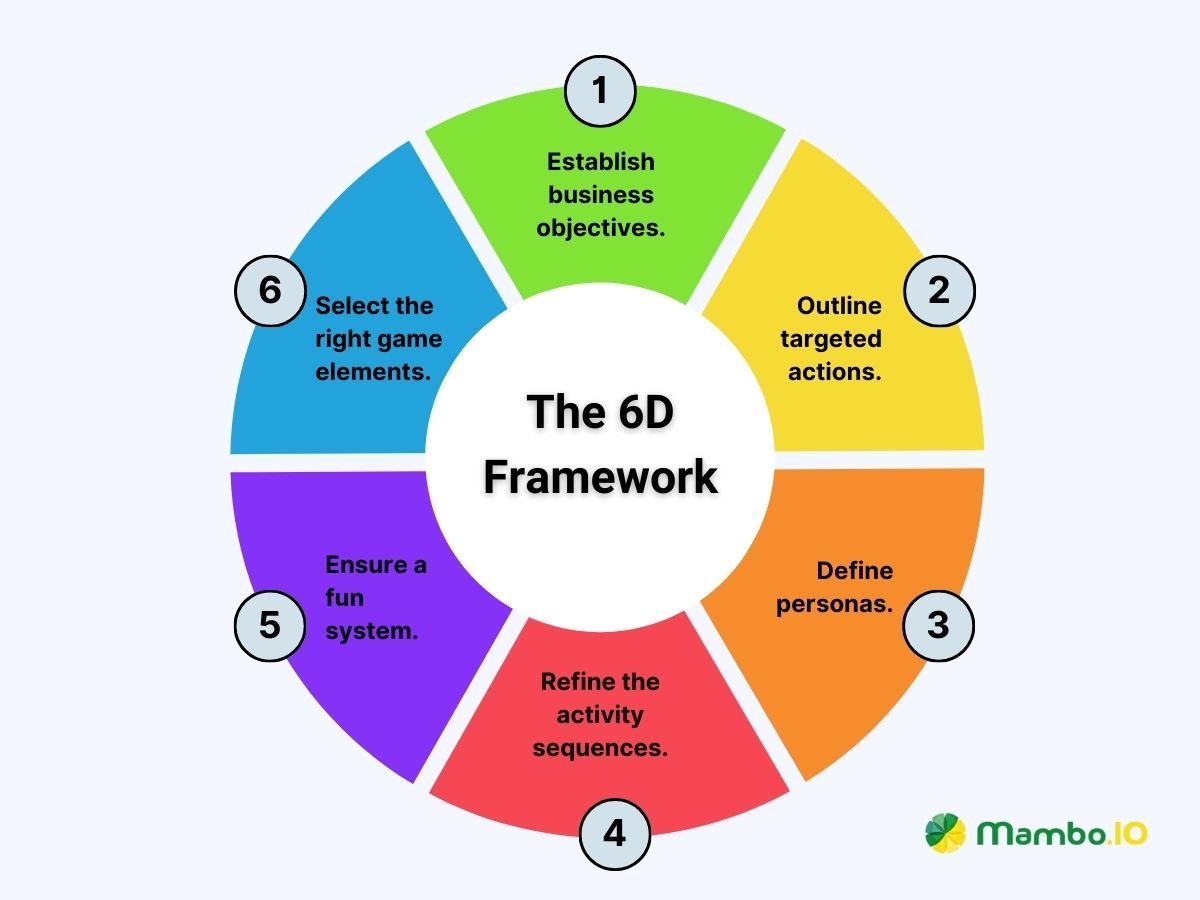
The 6D framework is a model for designing successful gamified systems, as outlined by Werbach & Hunter. Their framework consists of six steps that aim to help businesses create a gamified system that meets both business goals and user needs.
- Establish quantifiable business objectives. – The first step is to define clear business goals. Create a list with all potential objectives, rank them, delete any mechanics that are not goals in themselves, and justify each pursuit. The goal is to ensure that the gamified system meets business goals while creating a real user need.
- Outline targeted actions – The second step is to delineate target behaviours. Here you can brainstorm all possible target behaviours, prioritise behaviours, develop metrics for each behaviour, and define win states. The win states can be temporal, such as daily contests or ranks within a cohort, and long-term, such as level completion or cumulative badges.
- Define personas – The third step is to describe your players or develop personas. We can create personas based on the player lifecycle, skill level, and Bartle’s four player types. You can also decide on names and avatars for them. The goal is to understand what motivates each player type and design the gamified system to accommodate their needs.
- Refine the activity sequences – The fourth step is to devise activity cycles. The activity cycles can fall into engagement loops and branching trees. Engagement loops provide immediate feedback and further actions.
- Ensure a fun system – Fun is an essential aspect of a game because it is the primary motivator for players to participate and engage. It is what makes the experience enjoyable and memorable.
In short, fun is a crucial factor in creating a successful and engaging game.
To delve deeper into the concept of fun, Lazzaro has identified four potential types of fun:
-
- Hard Fun – Fun from overcoming challenges
- Easy Fun – Fun from releasing stress
- Experimental Fun – Fun from trying new experiences and learning
- Social Fun – Fun from interacting with others.
As you design for the four-player types, according to Bartle, consider all four fun activities in your gamification efforts to maximise engagement and satisfaction.
- Select the correct game elements. You can add many game elements to your system, and it’s okay if you understand the purpose and potential impact. With your business goals, target behaviours, personas, and activity cycles defined, it’s time to decide on the game elements to use.
Some common game elements include the PBL (points, badges and levels) elements:
Points – can motivate players to engage in desired behaviours. They also clearly indicate progress and can be used to measure success.
Badges – can reward players for reaching specific milestones or completing challenges. They serve as a form of recognition and can be used to show off to others.
Levels – levels provide a way for players to measure their progress and determine their rank. As players progress through levels, they may earn rewards and gain access to new features.
Additionally, you can also use gamification elements such as:
Leaderboards provide a way for players to compare their progress to others. This element can be a motivator for players who enjoy competition and can also serve as a way to measure success.
Virtual currency – tokens or coins- can be used to purchase in-game items, trade with others, or real-world exchange money. This element provides an additional incentive for players to engage in desired behaviours.
Check 108 gamification elements to implement in your gamification design strategy.
#3. Player-centred design framework (2013)
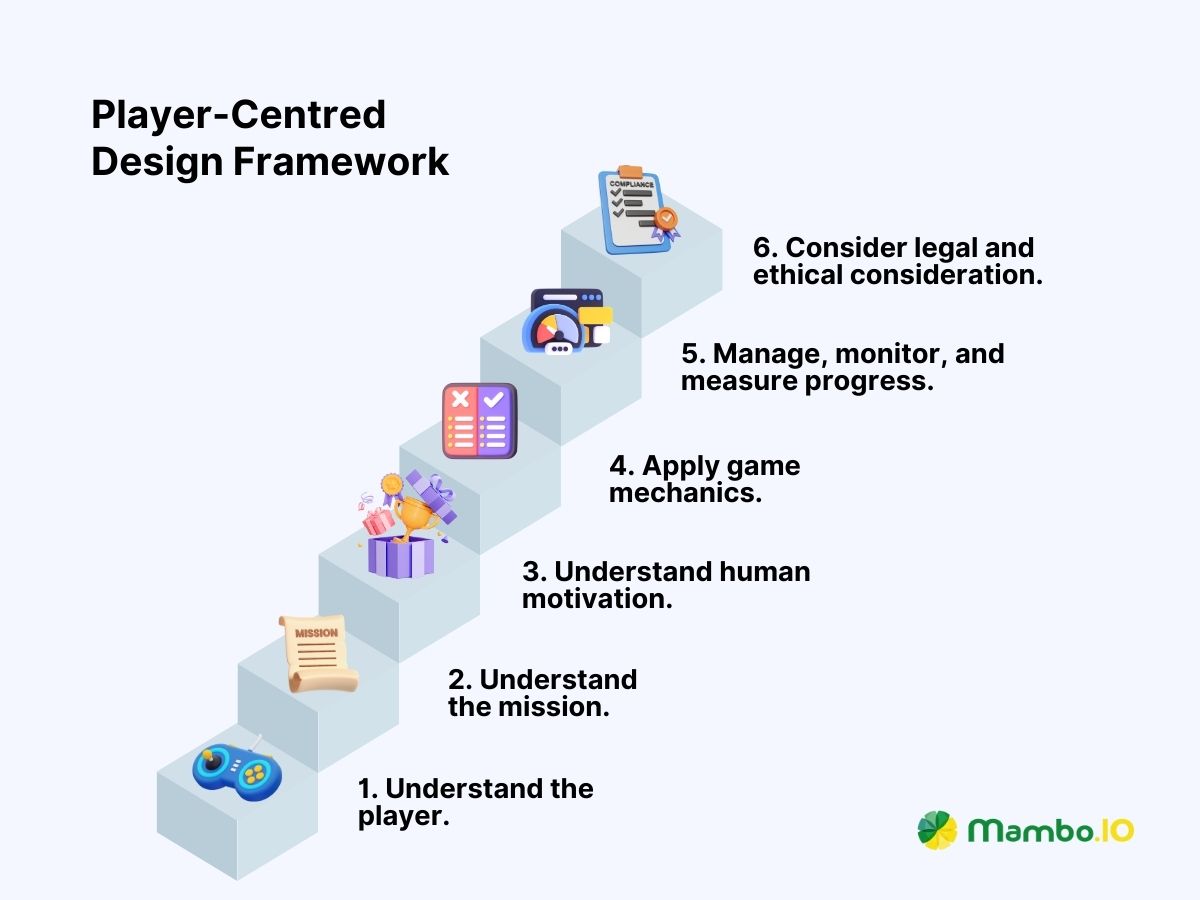
Janaki Kumar and Mario Herger introduced a new approach to implementing gamification into enterprise software.
Instead of focusing on mechanics immediately, they suggest adopting a process inspired by “user-centred design”, which puts the user’s goals at the centre of the design process.
The process of player-centred design consists of six steps:
- Understanding the player
- Understanding the mission
- Understanding human motivation
- Applying game mechanics
- Managing, monitoring, and measuring progress
- Considering legal and ethical considerations in the enterprise context.
First, it is essential to understand the player and their context to ensure that the project fits their needs. Who is your player? A customer, an employee, a supplier?
The next step is clearly defining the mission by examining the current business situation and determining the desired outcome, aligning the objective with what players are currently doing and what management hopes to achieve.
The third step in designing a game involves understanding the principles of human motivation to ensure the game mechanics are engaging and effective.
This requires a deep understanding of what motivates people to play games, such as the desire for achievement, social connection, and the thrill of competition.
Developers can increase player engagement, satisfaction, and retention by incorporating these motivators into the game design.
For example, a game designer may use a reward system that acknowledges a player’s progress, such as levelling up or earning in-game currency, to tap into the desire for achievement.
On the other hand, incorporating multiplayer options can cater to the social aspect of gaming and allow players to compete or cooperate with others.
The key is understanding what drives player behaviour and using this knowledge to create meaningful and enjoyable mechanics.
To understand the main theories of human motivation, see also:
- Content theories of motivation
- Process theories of motivation and business applications
- Behaviour change using gamification
The fourth step is to apply these game mechanics to create a positive flow for the project.
The fifth step involves continuously managing, monitoring, and measuring progress to ensure the project’s success.
Finally, there are legal and ethical considerations in the enterprise context must be taken into account. Consider compliance with privacy laws and regulations, ethical use of data and player information.
In like manner, ensure that the gamification elements align with company values and policies to avoid potential legal or ethical disputes.
#4. Gamifying Business: Designing motivating solutions to problem situations (2013)
In the article “Gamification in Business: Designing Motivating Solutions to Problem Situations“, Deborah Gears and Karen Braun developed a gamification design model to improve business project staffing by offering employees a positive and engaging experience.
The model is based on game design principles and incorporates employees’ psychological needs through the theory of 16 basic desires and the self-determination theory.
In their process, they combined game design principles with object-oriented systems development processes to include contextual elements and the psychological needs of employees.
The theory of 16 basic desires is a psychological content theory of motivation that provides a way to analyse and predict human behaviour.
The model is based on Reiss’ study of Maslow’s theory of human needs and William James’ theory of internal desires and describes 16 basic desires for things like order, power, independence, curiosity, acceptance, saving, and more.
The self-determination theory (SDT) recognises the social and environmental conditions that affect personal volition and engagement in activities and combines content and process motivation.
Strong basic desires for power, independence, idealism, and curiosity prompt engagement behaviours. At the same time, contextual influences affected participation along the SDT continuum ranging from external control to internal autonomy.
#5. The Octalysis Framework (2015)
The Octalysis Framework is a renowned gamification design framework that provides insights into the eight core drives that motivate human behaviour.
Developed by Yu-Kai Chou, the framework assumes that while systems are “function-focused” and designed to complete tasks as quickly as possible, humans have emotions, insecurities, and motivations that we need to consider to optimise engagement, motivation, and ROI.
According to Yu-Kai-Chou, the eight core drives are:
- Epic Meaning and Calling: This drive happens when individuals perceive that they are contributing to a cause greater than themselves and experience a sense of purpose or mission. For example, forum volunteers contribute to the development of its content.
- Development and Accomplishment: This drive is about growth and the desire to achieve goals. It’s associated with points, badges, and leaderboard systems (PBLs).
- Empowerment of Creativity and Feedback: This drive expresses when users are engaged in a creative process and need ways to express themselves and receive feedback on their creations. This drive is why activities like playing with Legos, Minecraft, and making art are fun.
- Ownership and Possession: This drive refers to the feeling of ownership and controls over something. When people feel they own something, they have an innate desire to improve it.
- Social Influence and Relatedness: This drive incorporates all the social elements that motivate people, including mentorship, social acceptance, companionship, and competition.
- Scarcity and Impatience: This drive is the motivation to want something because it is rare, exclusive, or unattainable. This drive is present in games with appointment dynamics or torture breaks, where rewards are only available after a specific time.
- Unpredictability and Curiosity: This drive is the constant engagement in something due to not knowing what will happen next. This drive is present in gambling addictions and sweepstakes/lottery programs.
- Loss and Avoidance: This drive motivates people to avoid negative consequences or losing something. On a small scale, it could be to avoid losing previous work or changing behaviour, while on a larger scale, it could be to avoid admitting failure.
Gamification design framework’s list
Out of the sources we’ve scoured, including databases, libraries, journals, and search engines, 2314 unique works about gamification design frameworks are documented. That’s quite a lot!
For this reason, we categorised the main design frameworks for business, learning, health, and general purpose. Here’s the complete list:
- Werbach and Hunter (2012) – 6D is a popular gamification design framework focusing on defining business objectives, describing players, devising engaging activity loops, and deploying gamification tools.
- Kumar (2013) – It covers understanding the player, mission, motivation, game mechanics, rules, engagement loops, monitoring and legal and ethical issues.
- Gears and Braun (2013) – RMI framework facilitates gameful interactions through a user-centred design approach that considers elements like objectives, business rules, behavioural norms, preconditions, actors, and actions.
- Julius and Salo (2013) – This framework focuses on marketing in the business context. It builds upon the 6D framework with the added stage of market research.
- Popa (2013) – This is a gamification framework for productivity software that focuses on creating emotional experiences through gamification personas that consist of user goals, emotions, and personality types.
- Jacobs (2013) – An enterprise gamification framework with five steps: understanding goals and impact, defining goals, considering users and social media, feedback and data analysis, and loop engagement.
- Jimenez (2013) – Also known as the Gamification Model Canvas, based on the Business Model Generation Canvas and MDA framework. It considers revenues, players, behaviours, aesthetics, dynamics, components, mechanics, platforms, and costs.
- Herzig (2014) – A technology-centred design process for gamification development based on literature review and different phases, including business modelling, requirements, iterative design, implementation, testing, deployment and monitoring.
- Raftopoulos (2014) – This is a conceptual model for sustainable gamification design (SGD) that aims to yield a minimum viable strategy for gameful enterprise applications with stages of discovering, reframing, envisioning, and creating.
- Burke (2014) – A player experience design process for gameful applications, considering business outcomes, target audience, player goals, engagement model, play space and journey, game economy, play tests and iterations.
- Harms et al. (2014) – A structured design process for gamifying surveys based on the MDA framework and form design layers with four steps: aesthetics and relationship layer, dynamics and conversation, mechanics and appearance, prototyping, evaluation, and iteration.
- Schonen (2014) – This is a theoretical framework for gamification in change management based on the 6D framework and empirical findings. It aims to determine the best time for applying gamification and decision criteria.
- Li (2014) – This design proposes a theoretical model for gamification in the workplace based on the Technology Acceptance Model (TAM). This model determines the perceived usefulness (PU), perceived ease of use (PEOU), and impact of gamification in the workplace.
- Neeli (2015) – This gamification design framework consists of 6 phases: setting goals and objectives, understanding challenges and motivations, analysing motivations, designing, measuring and improving, and engaging boosters.
- Brito et al. (2015) – A conceptual framework for designing gamification in crowdsourcing-based systems with 4 phases: gathering, analysis, modelling, and execution.
- Ruhi (2015) – This framework is an adaptation of the MDA framework for enterprise gamification that connects end-user motivations, gameplay elements, technology features, and functions with guidelines for design and management.
- Robson al. (2015) – The MDE framework is a methodology that focuses on three key components – Mechanics, Dynamics, and Emotions.
- Simoes et al. (2012) – A Social Gamification Framework for Social Learning Environments
This framework aims to integrate common elements from video games into social learning environments to enhance students’ motivation and learning outcomes. The framework applies game thinking and game elements, including goal orientation, achievement, reinforcement, competition, and fun direction.
- Nah, Telaprolu et al. (2013) – A Framework for Gamifying Educational Applications
This framework guides software designers and researchers in gamifying educational applications. It focuses on using game-thinking and game mechanics and elements to engage users and solve problems. There are five principles: goal orientation, achievement, reinforcement, competition, and fun direction.
- Wongso et al. (2015) – A Framework for Agile Gamification of E-Learning
This framework is based on social engagement and applied to e-learning environments. It follows the Design Science Research Methodology and consists of five iterative phases: analysis, design, development, implementation, and evaluation.
- Mora et al. (2016) – An Iterative Framework for Agile Gamification of the Learning Experience
This framework consists of four phases: declaration, creation, execution, and learning. Based on the principles of Lean UX and Behaviour-Driven Development, and provides a methodology for agile gamification of the learning experience.
- Kotini and Tzelepi (2015) – A Gamification-Based Framework for Developing Computational Thinking Activities
This framework proposes using gamification strategies to enhance student involvement in learning environments, specifically in developing computational thinking activities. It guides the appropriate introduction and implementation of game-design elements into the learning environment.
- Klock and da Cunha (2015) – A Conceptual Framework for Engaging Students in Adaptive E-Learning Systems
This framework provides information on the elements, actors, data, and behaviours involved in the gamification process for engaging students in adaptive e-learning systems. It is based on the MDA and 6D frameworks and defines a set of dimensions for the gamification process.
Note: The MDA game-design framework (Hunicke et al. 2004) and the 6D framework inspired several frameworks. These include works by Fitz-Walter (2015), Kappen and Nacke (2013), Klock and da Cunha (2015), Neeli (2015), Robson et al. (2015), and Ruhi (2015).
- DiTommaso (2011) – The use of game-design elements in non-game contexts
DiTommaso’s framework is rooted in Self Determination Theory (SDT). It entails a step-by-step process that includes determining player motivations, creating goals and objectives, outlining skills, monitoring progress, specifying areas of interest, and desired results, conducting play tests, and refining the design.
- Nicholson (2012) – The use of game-design elements in non-game contexts
Nicholson’s framework covers the following topics: organismic integration theory, situational relevance, situated motivation, universal design for learning, and player-generated content.
- Sakamoto (2012)
Sakamoto’s gamification framework objective was to increase intrinsic motivation in daily life based on five factors: informative, empathetic, persuasive, economic, and ideological.
4.Kappen and Nacke (2013)
A design framework built on the Self Determination Theory (SDT) with five key components: the core of effective gamification, motivated behaviour, game experience, game design process, and enjoyment perception (fun).
5.Marache-Francisco and Brangier (2013)
A design guide and toolkit for the gamification process that takes into account the principles of human-computer interaction (HCI) to recognise the relevant factors. It covers three dimensions: sensory-motor, motivation, emotion and commitment, and cognitive interaction.
6.Francisco Aparicio (2013)
Here’s one more approach based on the Self Determination Theory. This framework aimed at enhancing participation and motivation in various tasks, consisting of three components: game core, engine, and interface.
- Marczewski (2013)
A streamlined framework known as GAME comprises two stages: task planning, which involves collecting information and understanding the goals and preferences of players, and design, which consists in incorporating relevant game elements, analysing data, gathering feedback, and launching the final product.
8.Merino de Paz (2013)
This design process is a three-phase guideline: 1) Establishing business goals, which encompasses determining suitability, forming a team, setting objectives, outlining outcomes, and profiling players. 2) Design involves identifying desired behaviours, selecting game components, and defining game design. 3) Implementation and maintenance, including development or acquisition, deployment, data collection, and continuous adjustment.
- Versteeg (2013)
A gamification design framework grounded in persuasive technology and guided by the moral design framework, which involves analysing ethics through defining ethical principles and values, conducting conceptual analysis, engaging stakeholders, and evaluating and refining the design through iteration.
- Manrique (2013)
A gamification design model, SMA, focuses on creating engaging and motivational gameful experiences through an iterative process. It comprises four key variables: goals, actions, players, and the system.
- Chou (2015)
A design framework called Octalysis forms an octagonal structure. It includes eight gameful elements: Epic Meaning and Calling, Scarcity and Impatience, Development and Accomplishment, Creativity and Feedback, Social Influence and Relatedness, Ownership and Possession, Unpredictability and Curiosity, and Loss and Avoidance.
12.Fitz-Walter (2015)
A gamification design framework that follows an iterative process and takes into account user experience, motivation, and the overall gamification experience. This framework involves three crucial steps: justification, design, and evaluation.
- Liu and Santhanam (2015)
This gamification framework is inspired by the Person-Artefact-Task (PAT) model, which examines user experiences in computer environments by considering the interaction between persons, tasks, and technology artefacts, including game-design elements.
- Almarshedi et al. (2015)
A framework for sustainable gamification that focuses on maximising the lasting impact of game-based applications by integrating three key elements: Flow Dimension Theory (Csikszentmihalyi 1990), drive motivation components (Pink 2011), and Self Determination Theory (Ryan and Deci 2000).
1.Rojas, Kapralos, and Dubrowski, (2014)
A framework that guides the implementation of gamification in the health sector, including health services, public health, and health-related social policy, comprises four stages: theoretical and model development, pilot testing, evaluation, and full-scale implementation.
- Charles and McDonough (2014)
A framework for gameful rehabilitation systems design that prioritises the needs of individuals, considers the visual appeal, integrates technology, and considers the surrounding environment.
Maximizing engagement: key factors to consider in gamification design
In the gamification design process, regardless of which framework you choose, it is crucial to prioritize the following factors: fun, motivation, social interaction, desired behaviours, player profiling, and player taxonomy.
By giving importance to these elements, you can develop a gamification plan that is engaging and enjoyable for the players and one that fulfils its intended purpose.
So remember these elements in your next design!
Important note
Fun is relevant in most frameworks, with only one exception (Wongso et al. 2015).
Motivation, being the core of the design process, is predominantly supported by the Self Determination Theory (SDT).
Most frameworks consider social interaction in the design process, while all address expected behaviours in the design process either explicitly or implicitly.
The identification of players and a good knowledge of their profiles are considered essential in most frameworks.
The use of player taxonomies, such as Bartle’s and Yee’s taxonomies, are also considered in several frameworks.
